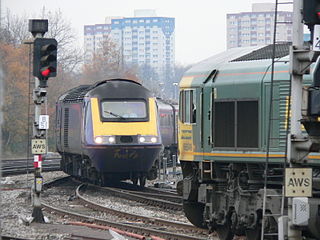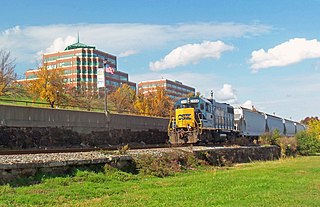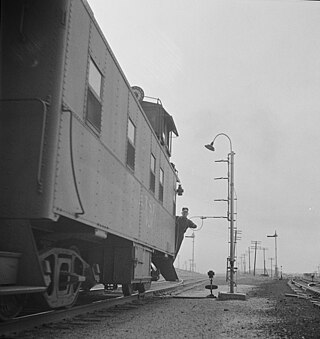
A railroad switch (AE), turnout, or [set of] points (CE) is a mechanical installation enabling railway trains to be guided from one track to another, such as at a railway junction or where a spur or siding branches off.

On a rail transport system, signalling control is the process by which control is exercised over train movements by way of railway signals and block systems to ensure that trains operate safely, over the correct route and to the proper timetable. Signalling control was originally exercised via a decentralised network of control points that were known by a variety of names including signal box, interlocking tower and signal cabin. Currently these decentralised systems are being consolidated into wide scale signalling centres or dispatch offices. Whatever the form, signalling control provides an interface between the human signal operator and the lineside signalling equipment. The technical apparatus used to control switches (points), signals and block systems is called interlocking.

Railway signalling (BE), or railroad signaling (AE), is a system used to control the movement of railway traffic. Trains move on fixed rails, making them uniquely susceptible to collision. This susceptibility is exacerbated by the enormous weight and inertia of a train, which makes it difficult to quickly stop when encountering an obstacle. In the UK, the Regulation of Railways Act 1889 introduced a series of requirements on matters such as the implementation of interlocked block signalling and other safety measures as a direct result of the Armagh rail disaster in that year.

In railway signalling, an interlocking is an arrangement of signal apparatus that prevents conflicting movements through an arrangement of tracks such as junctions or crossings. In North America, a set of signalling appliances and tracks interlocked together are sometimes collectively referred to as an interlocking plant or just as an interlocking. An interlocking system is designed so that it is impossible to display a signal to proceed unless the route to be used is proven safe.
A track warrant is a set of instructions issued to a train crew authorizing specific train movements. The system is widely used in North America. The warrant is issued by the train dispatcher and delivered to the train crew via radio. The train crew copies the instructions onto a pre-printed paper form and reads back the warrant to ensure that nothing was misunderstood.

Cab signaling is a railway safety system that communicates track status and condition information to the cab, crew compartment or driver's compartment of a locomotive, railcar or multiple unit. The information is continually updated giving an easy to read display to the train driver or engine driver.

The River Subdivision is a railroad line owned by CSX Transportation in the U.S. states of New Jersey and New York. The line runs from the North Bergen Yard in Hudson County, New Jersey north to Ravena, New York, along the alignment of the West Shore Railroad, a former New York Central Railroad line.

Jackfish is a ghost town in northern Ontario, Canada, located on the north shore of Lake Superior east of Terrace Bay.

Train order operation is a system for safely moving trains using train orders, as opposed to fixed signals or cab signalling. In train order operation, a "train order" is an order issued by or through a proper railway official to govern the movement of trains".
Australian railway signalling varies between the States of Australia, because the individual States are responsible for the railway systems within their own borders, with, historically, no need to co-ordinate between states except at the boundaries.
Standards for North American railroad signaling in the United States are issued by the Association of American Railroads (AAR), which is a trade association of the railroads of Canada, the US, and Mexico. Their system is loosely based on practices developed in the United Kingdom during the early years of railway development. However, North American practice diverged from that of the United Kingdom due to different operating conditions and economic factors between the two regions. In Canada, the Canadian Rail Operating Rules (CROR) are approved by the Minister of Transport under the authority of the Railway Safety Act. Each railway company or transit authority in Canada issues its own CROR rulebook with special instructions peculiar to each individual property. Among the distinctions are:

Signaling and operation on the Washington Metro system involves train control, station identification, train signaling, signage, and train length. As with any working railroad, communication between train operators, dispatchers, station personnel and passengers is critical. Failures will result in delays, accidents, and even fatalities. It is therefore important that a comprehensive signal system operated by a central authority be in place. This gives individual train and station operators the information they need to safely and efficiently perform their tasks.

Signalling block systems enable the safe and efficient operation of railways by preventing collisions between trains. The basic principle is that a track is broken up into a series of sections or "blocks". Only one train may occupy a block at a time, and the blocks are sized to allow a train to stop within them. That ensures that a train always has time to stop before getting dangerously close to another train on the same line. The block system is referred to in the UK as the method of working, in the US as the method of operation, and in Australia as safeworking.

A train dispatcher (US), rail traffic controller (Canada), train controller (Australia), train service controller (Singapore) or signaller (UK), is employed by a railroad to direct and facilitate the movement of trains over an assigned territory, which is usually part, or all, of a railroad operating division. The dispatcher is also responsible for cost effective movement of trains and other on-track railroad equipment to optimize physical (trains) and human resource (crews) assets.
Direct traffic control (DTC) is a system for authorizing track occupancy used on some railroads instead of or in addition to signals. It is known as "direct" traffic control because the train dispatcher gives track authority directly to the train crew via radio, as opposed to through wayside personnel via telephone or telegraph, as in train orders.

Metlink's Kapiti Line is the electrified southern portion of the North Island Main Trunk railway between New Zealand's capital city, Wellington, and Waikanae on the Kāpiti Coast, operated by Transdev Wellington on behalf of Greater Wellington Regional Council. Trains run frequently every day, with stops at 16 stations. Until 20 February 2011 it was known as the Paraparaumu Line.

Automatic block signaling (ABS), spelled automatic block signalling or called track circuit block (TCB) in the UK, is a railroad communications system that consists of a series of signals that divide a railway line into a series of sections, called blocks. The system controls the movement of trains between the blocks using automatic signals. ABS operation is designed to allow trains operating in the same direction to follow each other in a safe manner without risk of rear-end collision.

Advanced Civil Speed Enforcement System (ACSES) is a positive train control cab signaling system developed by Alstom. The system is designed to prevent train-to-train collisions, protect against overspeed, and protect work crews with temporary speed restrictions. The information about permanent and temporary speed restrictions is transmitted to the train by transponders (Balises) lying in the track, coded track circuits and digital radio. It was installed beginning in 2000 on all of Amtrak's Northeast Corridor between Washington and Boston, and has been fully active since December 2015, a few months after the 2015 Philadelphia train derailment which it would have prevented.

The application of railway signals on a rail layout is determined by various factors, principally the location of points of potential conflict, as well as the speed and frequency of trains and the movements they require to make.

The Signals, Crane and Subway are heritage-listed railway infrastructure at Charters Towers railway station, Enterprise Road, Charters Towers, Charters Towers Region, Queensland, Australia. They were added to the Queensland Heritage Register on 30 October 2008.



















